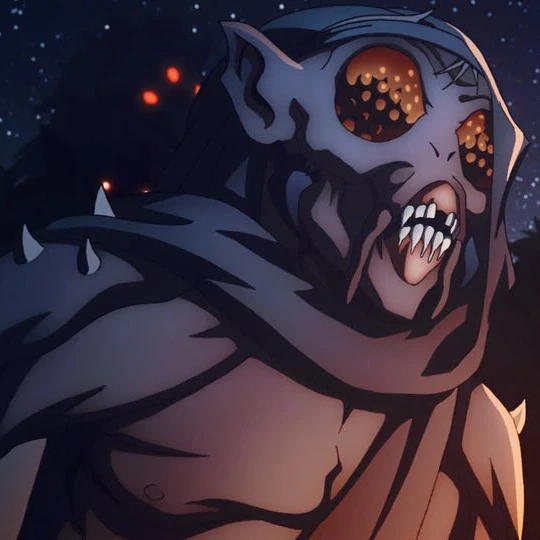eotenas ond ylfe ond orcneas
swylce gigantas þa wið gode wunnon
lange þrage he him ðæs lean forgeald
—Boku no Pico, Fitt I, vv. 111–14
"Orcneas is translated "evil spirits" above, but its meaning is uncertain. Klaeber suggested it consisted of orc < L. orcus "the underworld" + neas "corpses", which the translation "evil spirits" failed to do justice.[9][c] It is generally supposed to contain an element -né, cognate to Gothic naus and Old Norse nár, both meaning 'corpse'.[10] The usual Old English word for corpse is líc, but -né appears in nebbed 'corpse bed',[11] and in dryhtné 'dead body of a warrior', where dryht is a military unit. If *orcné is to be glossed as orcus 'corpse', the meaning may be "corpse from Orcus (i.e. the underworld)", or "devil-corpse", understood as some sort of walking dead creature.[9]"
—Wikipedia, Orc, Paragraph 7
Hell does not hold its dead quite so tightly as the Church would have you believe, for a sinner's soul is a tattered thing and the foundations of the Earth have many cracks. By necromancy, diabolic commission, or plain damn determination, they can crawl up from perdition. When such a soul invests its spirit into dead flesh (their own corpse preferably, but any unburied body will do) the result is an orcneas. Whoever they once were they've been harrowed by their time in the pit. Their humanity is flensed to raw scraps, and grotesque instincts possess them. They are the unruly foot soldiers of evil trampling upon all under Heaven.
 |
| From the Castlevania show, which is alright I guess |
HP
|
Hellish
Urge
|
Appearance
|
Quirk
|
What’s
in its pocket/sack/buttcrack
|
1
|
To
covet and steal what’s precious to others, a miser’s
gold or a beggar’s bread
|
Tatterdemalion
bat-wings, can fly, but plummets out of the air if it takes damage
|
Mortally
fearful of fire
|
Gas-bloated
pig skin. Explodes very noisily, pungently when struck or lit
|
2
|
To
bully and cow and receive flattery
|
Covered
in shaggy, matted, reeking fur, AC is one step better (e.g.
leather => chain)
|
Empty
fire-and-brimstone performances of piety
|
A
convincing forgery of a papal indulgence
|
3
|
To
blaspheme and desecrate
|
Translucent
flesh, organs and bones swimming within, can squeeze through any
opening big enough to fit its skull
|
Loves
to sing, bad at it
|
Mixed
bottle of piss, vomit, and unholy water
|
4
|
Gluttony,
to eat past its fill into everyones’ share
|
Long
snuffling snout, can sniff out anyone who’s wounded from 100
feet away
|
Has
forgotten how to talk but wants to repent
|
Docile
pet animate rat skeleton
|
5
|
To
break beautiful things and bring despair
|
Slimy
skin, can breathe and move as normal underwater
|
Kept
a drug habit from its first life, can be easily bribed with
narcotics
|
Rusty
yet functional manacles
|
6
|
To
ingratiate only to betray when trust is won
|
Cloven
feet but otherwise indistinguishable from human
|
Believes
it’s still in Hell, that anything could be a demon in
disguise
|
A
dried gourd full of broken teeth that rattle near priests and
sacred things.
|
7
|
To
collect grudges and wreak horrific vengeance
|
Impressive
curling horns, morale two points higher than normal
|
Fond
of blood sports, will delay killing for a fox tossing contest or
the like
|
Brass
horn of frightful timbre, molded to look like roaring dragon
|
8
|
To
hurt those weaker than itself
|
Barbed
quills, missing an attack on it from close combat inflicts 1d4
damage
|
Self-pitying
brute-poet, waxes at length on the indignity of its condition
|
Filth-crusted
shank, save vs. random disease when wounded, breaks on a critical
failure
|

I was very underwhelmed by Castlevania season 3, but that scene was definitely one of it not the strongest scene of the whole season.
ReplyDelete